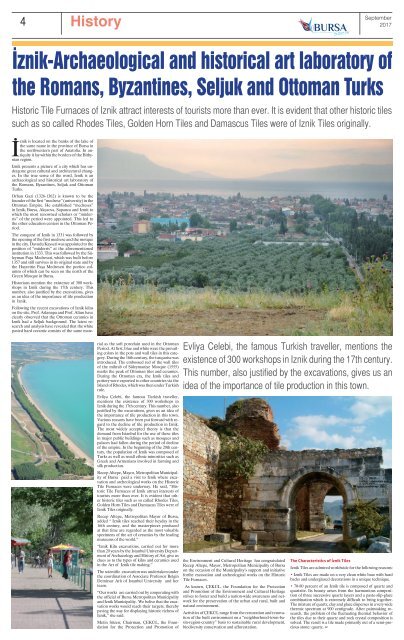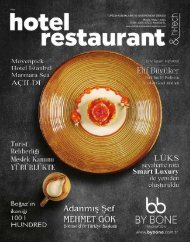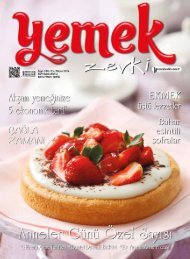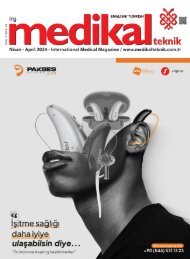Made In Bursa September 2017
You also want an ePaper? Increase the reach of your titles
YUMPU automatically turns print PDFs into web optimized ePapers that Google loves.
4 History<br />
<strong>September</strong><br />
<strong>2017</strong><br />
İznik-Archaeological and historical art laboratory of<br />
the Romans, Byzantines, Seljuk and Ottoman Turks<br />
Historic Tile Furnaces of Iznik attract interests of tourists more than ever. It is evident that other historic tiles<br />
such as so called Rhodes Tiles, Golden Horn Tiles and Damascus Tiles were of Iznik Tiles originally.<br />
İznik is located on the banks of the lake of<br />
the same name in the province of <strong>Bursa</strong> in<br />
the northwestern part of Anatolia. <strong>In</strong> antiquity<br />
it lay within the borders of the Bithynian<br />
region.<br />
İznik presents a picture of a city which has undergone<br />
great cultural and architectural changes.<br />
<strong>In</strong> the true sense of the word, İznik is an<br />
archaeological and historical art laboratory of<br />
the Romans, Byzantines, Seljuk and Ottoman<br />
Turks.<br />
Orhan Gazi (1326-1362) is known to be the<br />
founder of the first “medrese” (university) in the<br />
Ottoman Empire. He established “medreses”<br />
in İznik, <strong>Bursa</strong>, Akçaova, Sapanca and İzmit to<br />
which the most renowned scholars or “müderris”<br />
of the period were appointed. This led to<br />
the other education centers in the Ottoman Period.<br />
The conquest of İznik in 1331 was followed by<br />
the opening of the first medrese and the mosque<br />
in the city. Davudu Kayseri was appointed to the<br />
position of “müderris” at the aforementioned<br />
institution in 1333. This was followed by the Süleyman<br />
Paşa Medresesi, which was built before<br />
1357 and still survives in its original state and by<br />
the Hayrettin Paşa Medresesi the portico columns<br />
of which can be seen on the north of the<br />
Green Mosque in <strong>Bursa</strong>.<br />
Historians mention the existence of 300 workshops<br />
in İznik during the 17th century. This<br />
number, also justified by the excavations, gives<br />
us an idea of the importance of tile production<br />
in İznik.<br />
Following the recent excavations of İznik kilns<br />
on the site, Prof. Aslanapa and Prof. Altun have<br />
clearly observed that the Ottoman ceramics in<br />
İznik had a Seljuk background. The latest research<br />
and analysis have revealed that the white<br />
pasted hard ceramic consists of the same material<br />
as the soft porcelain used in the Ottoman<br />
Period. At first, blue and white were the prevailing<br />
colors in the pots and wall tiles in this category.<br />
During the 16th century, the turquoise was<br />
introduced. The embossed red of the wall tiles<br />
of the mihrab of Süleymaniye Mosque (1555)<br />
marks the peak of Ottoman tiles and ceramics.<br />
During the Ottoman era, the İznik tiles and<br />
pottery were exported to other countries via the<br />
Island of Rhodes, which was then under Turkish<br />
rule.<br />
Evliya Çelebi, the famous Turkish traveller,<br />
mentions the existence of 300 workshops in<br />
İznik during the 17th century. This number, also<br />
justified by the excavations, gives us an idea of<br />
the importance of tile production in this town.<br />
Various reasons have been put forward with regard<br />
to the decline of tile production in İznik.<br />
The most widely accepted theory is that the<br />
demand from Istanbul for the use of these tiles<br />
in major public buildings such as mosques and<br />
palaces had fallen during the period of decline<br />
of the empire. <strong>In</strong> the beginning of the 20th century,<br />
the population of İznik was composed of<br />
Turks as well as small ethnic minorities such as<br />
Greek and Armenians involved in farming and<br />
silk production.<br />
Recep Altepe, Mayor, Metropolitan Municipality<br />
of <strong>Bursa</strong> paid a visit to İznik where excavation<br />
and archeological works on the Historic<br />
Tile Furnaces were underway. He said, “Historic<br />
Tile Furnaces of Iznik attract interests of<br />
tourists more than ever. It is evident that other<br />
historic tiles such as so called Rhodes Tiles,<br />
Golden Horn Tiles and Damascus Tiles were of<br />
Iznik Tiles originally.<br />
Recep Altepe, Metropolitan Mayor of <strong>Bursa</strong>,<br />
added “ İznik tiles reached their heyday in the<br />
16th century, and the masterpieces produced<br />
at that time are regarded as the most valuable<br />
specimens of the art of ceramics by the leading<br />
museums of the world.”<br />
“İznik Kiln excavations, carried out for more<br />
than 20 years by the Istanbul University Department<br />
of Archaeology and History of Art, give us<br />
clues as to the types of kilns and ceramics used<br />
in the Art of İznik tile making.”<br />
The scientific excavation was undertaken under<br />
the coordination of Associate Professor Belgin<br />
Demirsar Arlı of Istanbul University and her<br />
team.<br />
“Our works are carried out by cooperating with<br />
the official of <strong>Bursa</strong> Metropolitan Municipality<br />
and İznik Municipality. We belive that the excavation<br />
works would reach their targets, thereby<br />
paving the way for displaying historic richess of<br />
İznik,” she said.<br />
Metin Sözen, Chairman, ÇEKÜL, the Foundation<br />
for the Protection and Promotion of<br />
Evliya Celebi, the famous Turkish traveller, mentions the<br />
existence of 300 workshops in Iznik during the 17th century.<br />
This number, also justified by the excavations, gives us an<br />
idea of the importance of tile production in this town.<br />
the Environment and Cultural Heritage has congratulated<br />
Recep Altepe, Mayor, Metropolitan Municipality of <strong>Bursa</strong><br />
on the occasion of the Municipality’s support and initiative<br />
forthe excavation and archeological works on the Historic<br />
Tile Furnaces.<br />
As known, ÇEKÜL, the Foundation for the Protection<br />
and Promotion of the Environment and Cultural Heritage<br />
strives to foster and build a nation-wide awareness and network<br />
for the preservation of the urban and rural, built and<br />
natural environment.<br />
Activities of ÇEKÜL range from the restoration and renovation<br />
of the built environment on a “neighborhood-town-basin-region-country”<br />
basis to sustainable rural development,<br />
biodiversity conservation and afforestation.<br />
The Characteristics of İznik Tiles<br />
İznik Tiles are admired worldwide for the following reasons:<br />
• İznik Tiles are made on a very clean white base with hard<br />
backs and underglazed decorations in a unique technique.<br />
• 70-80 percent of an İznik tile is composed of quartz and<br />
quartzite. Its beauty arises from the harmonious composition<br />
of three successive quartz layers and a paste-slip-glaze<br />
combination which is extremely difficult to bring together.<br />
The mixture of quartz, clay and glaze disperses in a very wide<br />
thermic spectrum at 900 centigrade. After painstaking research,<br />
the problem of the fluctuating thermal behavior of<br />
the tiles due to their quartz and rock crystal composition is<br />
solved. The result is a tile made primarily out of a semi-precious<br />
stone: quartz. ➢

















